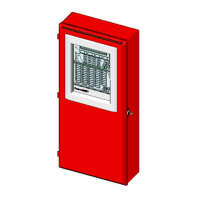Installation
P/N 06-237058-001 2-29 February 2012
2-8.5.1 CROSS ZONE INITIATING DEVICES
Applications which utilize two detectors to initiate the activation of a suppression system, known as
cross or counting zone detection, must comply with the following:
1. Must be acceptable by the local Authority Having Jurisdiction (AHJ).
2. A minimum of two (2) detectors must be used in each protected space.
3. The distance from one detector to another must be 0.7 times the standard linear spacing
determined in accordance with NFPA 72.
4. The Alarm Verification feature cannot be used in cross zoned applications.
The two detector/cross or counting zone configuration is generally used for the actuation of
suppression systems but can also be used as part of an alarm notification system.
2-8.5.2 USE OF ADDRESSABLE OUTPUT MODULES
In order to meet the requirements of UL864 33.1.2.a, the ARIES NETLink system is limited to a
maximum of 14 addressable output modules that are programmed to activate in response to an
Alarm or Supervisory condition from an SLC-based initiating device. These modules include
SmartOne Model AO Addressable Relay Modules, SmartOne Model ASM Addressable Signal Modules
and SmartOne Remote Releasing Modules.
If RRMs are programmed for grouping release, a maximum of 80 RRMs can be activated within 10
seconds on a single SLC circuit. If RRMs are spread across SLC modules, then 7 groups of 20 RRMs
each can be activated within 10 seconds.
For networked systems, refer to the table below:
Table 2-3. Activation of Outputs with Grouping for Networked Control Units
Number of Nodes
Number of AO/ ASMs/ RRMs
on the Same SLC Loop
Total Time From Alarm to
Complete Activation of All
Outputs with Grouping
up to 4 nodes 40 RRMs, 41 ASMs/AOs 9 seconds
5 to 8 nodes 40 RRMs, 41 ASMs/AOs 9.2 seconds
9 to 12 nodes 40 RRMs, 41 ASMs/AOs 9.4 seconds
13 to 16 nodes 40 RRMs, 40 ASMs/AOs 9.6 seconds
17 to 20 nodes 40 RRMs, 40 ASMs/AOs 9.8 seconds
21 to 24 nodes 40 RRMs, 22 ASMs/AOs 9.5 seconds
25 to 28 nodes 40 RRMs, 22 ASMs/AOs 9.8 seconds
29 to 32 modes 40 RRMs, 21 ASM or AO 9.5 seconds
33 to 36 nodes 40 RRMs, 21 ASM or AOs 9.8 seconds
37 to 40 nodes 40 RRMs, 20 ASM or AOs 9.6 seconds
41 to 44 nodes 40 RRMs, 20 ASM or AOs 9.9 seconds
45 to 48 nodes 20 RRMs, 22 ASM or AOs 9.7 seconds
49 to 52 nodes 20 RRMs, 21 ASM or AOs 9.6 seconds
53 to 56 nodes 20 RRMs, 21 ASM or AOs 9.9 seconds
57 to 60 nodes 20 RRMs, 20 ASM or AOs 9.8 seconds
61 to 64 nodes 20 RRMs, 2 ASM or AOs 9.7 seconds

